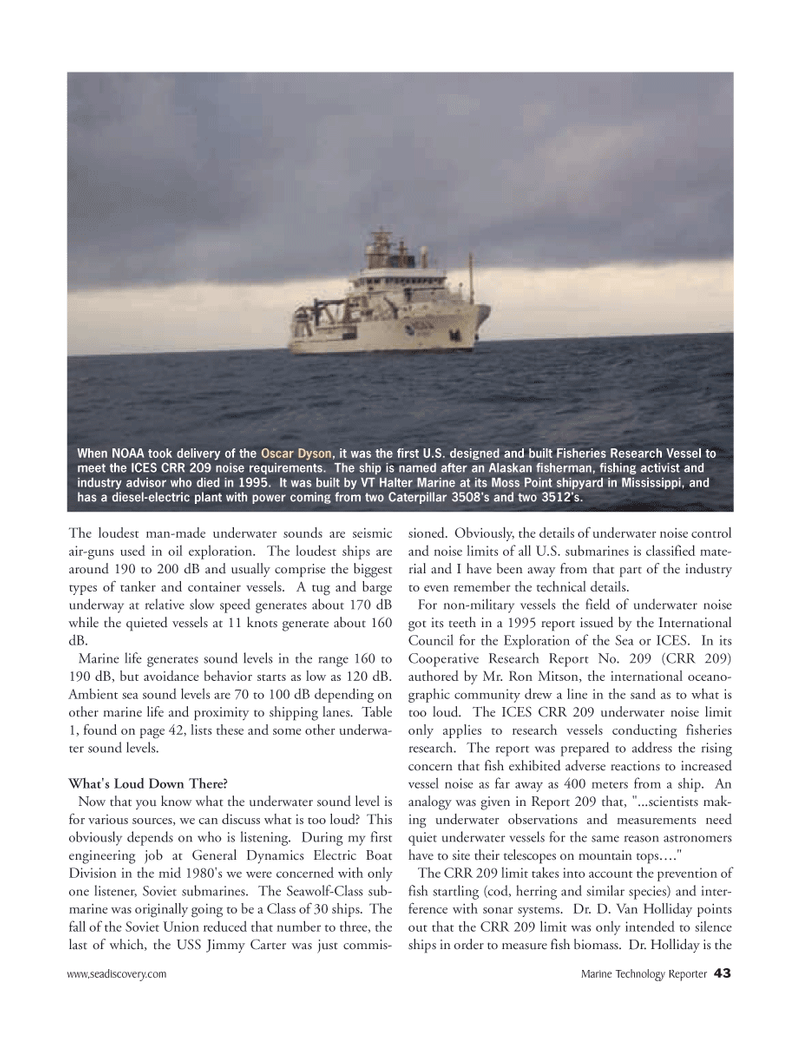
Page 42: of Marine Technology Magazine (July 2005)
Read this page in Pdf, Flash or Html5 edition of July 2005 Marine Technology Magazine
www,seadiscovery.com Marine Technology Reporter 43
The loudest man-made underwater sounds are seismic air-guns used in oil exploration. The loudest ships are around 190 to 200 dB and usually comprise the biggest types of tanker and container vessels. A tug and barge underway at relative slow speed generates about 170 dB while the quieted vessels at 11 knots generate about 160 dB.
Marine life generates sound levels in the range 160 to 190 dB, but avoidance behavior starts as low as 120 dB.
Ambient sea sound levels are 70 to 100 dB depending on other marine life and proximity to shipping lanes. Table 1, found on page 42, lists these and some other underwa- ter sound levels.
What's Loud Down There?
Now that you know what the underwater sound level is for various sources, we can discuss what is too loud? This obviously depends on who is listening. During my first engineering job at General Dynamics Electric Boat
Division in the mid 1980's we were concerned with only one listener, Soviet submarines. The Seawolf-Class sub- marine was originally going to be a Class of 30 ships. The fall of the Soviet Union reduced that number to three, the last of which, the USS Jimmy Carter was just commis- sioned. Obviously, the details of underwater noise control and noise limits of all U.S. submarines is classified mate- rial and I have been away from that part of the industry to even remember the technical details.
For non-military vessels the field of underwater noise got its teeth in a 1995 report issued by the International
Council for the Exploration of the Sea or ICES. In its
Cooperative Research Report No. 209 (CRR 209) authored by Mr. Ron Mitson, the international oceano- graphic community drew a line in the sand as to what is too loud. The ICES CRR 209 underwater noise limit only applies to research vessels conducting fisheries research. The report was prepared to address the rising concern that fish exhibited adverse reactions to increased vessel noise as far away as 400 meters from a ship. An analogy was given in Report 209 that, "...scientists mak- ing underwater observations and measurements need quiet underwater vessels for the same reason astronomers have to site their telescopes on mountain tops…."
The CRR 209 limit takes into account the prevention of fish startling (cod, herring and similar species) and inter- ference with sonar systems. Dr. D. Van Holliday points out that the CRR 209 limit was only intended to silence ships in order to measure fish biomass. Dr. Holliday is the
When NOAA took delivery of the Oscar Dyson, it was the first U.S. designed and built Fisheries Research Vessel to meet the ICES CRR 209 noise requirements. The ship is named after an Alaskan fisherman, fishing activist and industry advisor who died in 1995. It was built by VT Halter Marine at its Moss Point shipyard in Mississippi, and has a diesel-electric plant with power coming from two Caterpillar 3508's and two 3512's.
MTR#1 (33-48).qxd 7/19/2005 10:00 AM Page 43

 41
41

 43
43
